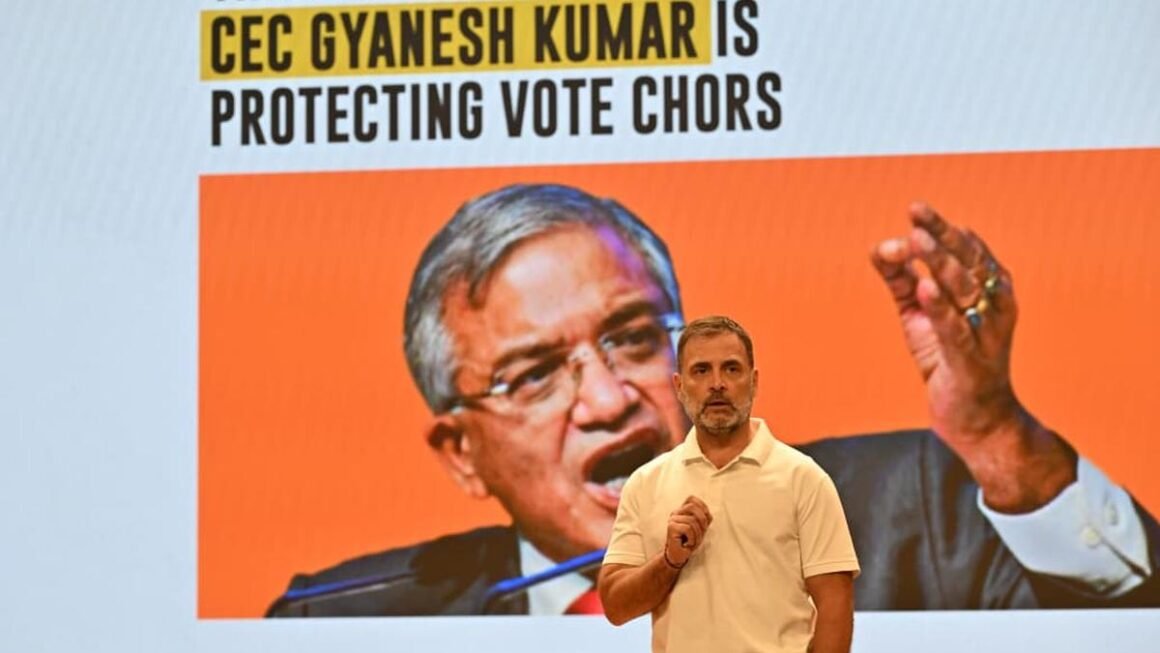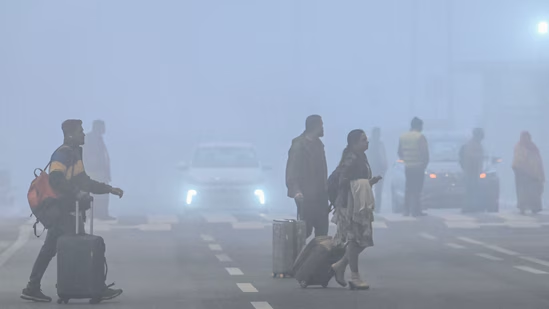
“By invoking Nepal’s youth revolution, Rahul Gandhi has thrown India’s Gen Z a challenge: march for democracy, or be remembered as the silent generation.”The Post That Shook Indian Politics in Minutes
At 9 PM on September 18, 2025, Rahul Gandhi pressed “post” on X—and within minutes, India’s political discourse went into overdrive. News tickers flashed his words, party spokespersons scrambled for reactions, and social media timelines erupted. This wasn’t just another campaign line; it felt like a digital shot fired across the bow of the ruling party.
In his message, Rahul Gandhi didn’t mince words. He directly appealed to the nation’s youth with a call that was patriotic yet provocative:
“देश के Yuva,
देश के Students,
देश की Gen Z,
संविधान को बचाएंगे,
लोकतंत्र की रक्षा करेंगे,
और वोट चोरी को रोकेंगे।
मैं उनके साथ हमेशा खड़ा हूं।
जय हिंद!”
(Translation: “The youth of the nation, the students of the nation, the Gen Z of the nation will save the Constitution, protect democracy, and stop vote theft. I stand with them always. Jai Hind!”)
The timing made it explosive. Just three days earlier, Nepal’s Gen Z-led protests had toppled Prime Minister K.P. Sharma Oli, a historic moment in South Asian politics. Rahul Gandhi’s appeal wasn’t merely about “vote chori”—it was read as a provocation, daring India’s Gen Z to follow the example set across the border.
Nepal’s Youth Earthquake: From TikTok Ban to a Fallen Prime Minister
The Nepal protests were triggered by a sudden ban on TikTok and Instagram on September 12, 2025. For a nation of 30 million where over 21 million are under 30, this was more than cultural regulation—it was a direct assault on youth identity.
But discontent was already simmering. Nepal’s GDP growth had slowed to 2.5% in 2024, youth unemployment had crossed 19%, and corruption scandals dogged the Oli government. The ban was the spark that lit the fire.
Within days, 1.5 lakh youth mobilized across 22 districts. Police violence left 12 dead, 1,200 arrested, and 3,500 injured. By September 15, Oli had resigned, and Nepal appointed its first woman interim Prime Minister. Hashtags like #NepalUprising trended globally, amplified by students in the US, Australia, and the Gulf.
For Rahul Gandhi, this wasn’t just Nepal’s story—it was a playbook for how Gen Z could force accountability.
India’s Gen Z: A Sleeping Giant With Numbers Too Big to Ignore
India’s Gen Z is the largest youth electorate in the world. In the 2024 elections, nearly 18 crore voters under 25 were eligible, including 4 crore first-time voters aged 18–19. By 2029, this generation will represent 35% of India’s electorate.
But the reality is sobering. First-time voter turnout in 2024 was just 55%, well below the national average of 66%. And frustration is high: youth unemployment stands at 23% among 20–24 year-olds (CMIE 2025), with 3.4 crore educated youth currently jobless (Labour Ministry data).
The education system hasn’t inspired trust either—exam leaks in Uttar Pradesh (22 lakh students affected in 2023) and Bihar (17 lakh in 2024) left millions disillusioned. Add to this the digital landscape—95% smartphone penetration among 18–25 year-olds and over 820 million internet users nationwide—and you have a generation that is hyper-connected but politically disengaged.
As one Delhi University student put it: “We don’t want to be used for protests. Give us jobs, not slogans.” This skepticism explains why Rahul Gandhi’s fiery appeal may not instantly ignite action.
BJP Strikes Back: From “Nepal Gandhi” Memes to Warnings of Anarchy
The BJP countered fiercely.
- Nishikant Dubey (MP) accused Rahul Gandhi of “dreaming of Nepal-style anarchy.”
- Anurag Thakur (Minister) claimed he wanted “Bangladesh and Nepal-like instability.”
The BJP IT Cell swung into action. In the first 48 hours:
- #NepalGandhi trended with 2.3 lakh tweets.
- #DynastForAnarchy hit 1.8 lakh mentions.
- BJP-aligned Instagram reels mocking Rahul Gandhi pulled 12 million views.
At the same time, BJP promoted Modi’s youth-focused initiatives: ₹1.2 lakh crore in start-up funding since 2016, 2.1 lakh Agniveer recruits trained in 2024–25, and 13,000 new skill development centers. The contrast was clear: Modi as builder of youth futures, Rahul Gandhi as instigator of unrest.
Congress’s Counter-Narrative: Casting Youth as Democracy’s Last Line of Defense
Congress wasn’t backing down. Spokesperson Supriya Shrinate branded BJP’s attacks as “IT Cell lies.” NSUI launched campus campaigns across 14 states, putting Rahul Gandhi’s appeal on posters and pamphlets. On X, #VoteChorGaddiChhod peaked at 90,000 tweets, though it fell short of BJP’s hashtag reach.
Rahul Gandhi backed his claim with data, citing surveys that 52% of young Indians don’t fully trust the Election Commission (CSDS–Lokniti 2024). His pitch is simple: Gen Z must act as “guardians of democracy”, filling the vacuum left by compromised institutions.
Nepal vs India: Why One Gen Z Rose and the Other Stayed Silent
The Nepal comparison is instructive.
- Nepal’s youth had a clear flashpoint: losing TikTok and Instagram.
- India’s youth face structural frustrations—joblessness, exam scandals, ECI mistrust—but no single, everyday trigger.
| Country | Trigger | Scale | Outcome |
| Nepal | TikTok/Instagram ban, corruption, unemployment | 1.5 lakh protesters across 22 districts, 12 dead, 1,200 arrested | PM Oli resigned, interim woman PM appointed |
| India | Alleged vote theft, ECI bias | No protests (as of Sept 19, 2025) | Debate, BJP counterattack, hashtag wars |
Until Indian Gen Z feels a direct disruption in their daily lives, their anger may remain digital.
ECI Fires Back: “Baseless Allegations” and a Stinging Reminder
The Election Commission of India (ECI) dismissed Rahul Gandhi’s allegations as “baseless,” pointing out that voter deletions follow a three-step verification. Karnataka’s CEO noted that Congress had actually won Aland constituency in 2023, the very seat Rahul Gandhi claimed was compromised.
Nationwide, 2.1 crore voters were deleted and 2.7 crore new voters added in 2023–24, reflecting regular roll updates rather than targeted fraud—at least on paper.
The Hidden Stakes: Why Rahul Gandhi Is Betting on Youth Before State Elections
Rahul Gandhi’s call wasn’t just symbolic—it was strategic. With state elections in Maharashtra, Haryana, and Bihar around the corner, Gen Z voters could tilt the scales.
- Maharashtra: Over 60 lakh first-time voters, youth unemployment at 19%.
- Haryana: 10 lakh students hit by exam leaks in 2024, anger simmering.
- Bihar: Nearly 1 crore voters under 25, many jobless or migrants.
Together, these states send 88 MPs to the Lok Sabha—a critical bloc ahead of 2029. Energizing youth here could be Rahul Gandhi’s chance to chip away at BJP dominance.
What If India’s Gen Z Actually Takes to the Streets?
Three possible scenarios loom:
- Indifference: Rahul Gandhi’s appeal fizzles; BJP projects stability.
- Symbolic action: Campus sit-ins, online campaigns, enough to shape perception.
- Mass uprising: A Nepal-style revolt triggered by another exam scandal, worsening unemployment, or a social media ban. Police crackdowns could then spark international headlines.
If the last happens, Rahul Gandhi’s September 18 post will be remembered as the spark, not the slogan.
Global Spotlight: Why the World Is Watching Rahul Gandhi’s Gamble
The world is paying attention. BBC called it a “bold gamble,” Al Jazeera described it as a “provocative echo of Nepal,” and The New York Times warned that India’s youth unemployment is “structurally worse than many smaller economies.”
For Modi, youth unrest would dent India’s global image as a stable democracy and growth engine. For Rahul Gandhi, it could elevate him as a generational challenger with international resonance.
A Borrowed Fire Still Searching for Fuel
Rahul Gandhi’s September 18 post was carefully timed, emotionally charged, and globally resonant. By invoking Nepal’s youth uprising, he positioned India’s Gen Z as potential defenders of democracy against “vote chori.” The BJP branded him reckless, the ECI dismissed his claims, and Congress insists Rahul Gandhi is merely fighting for accountability.
But the silence on India’s streets tells its own story. Unlike Nepal, where social media bans galvanized a generation, Indian Gen Z has yet to find its unifying spark. Until jobs, exams, or freedoms are directly threatened, Rahul Gandhi’s “vote chori” cry may remain a more viral moment than a mass movement.
FOR MORE BLOGS – beyondthepunchlines.com

 Add to favorites
Add to favorites








